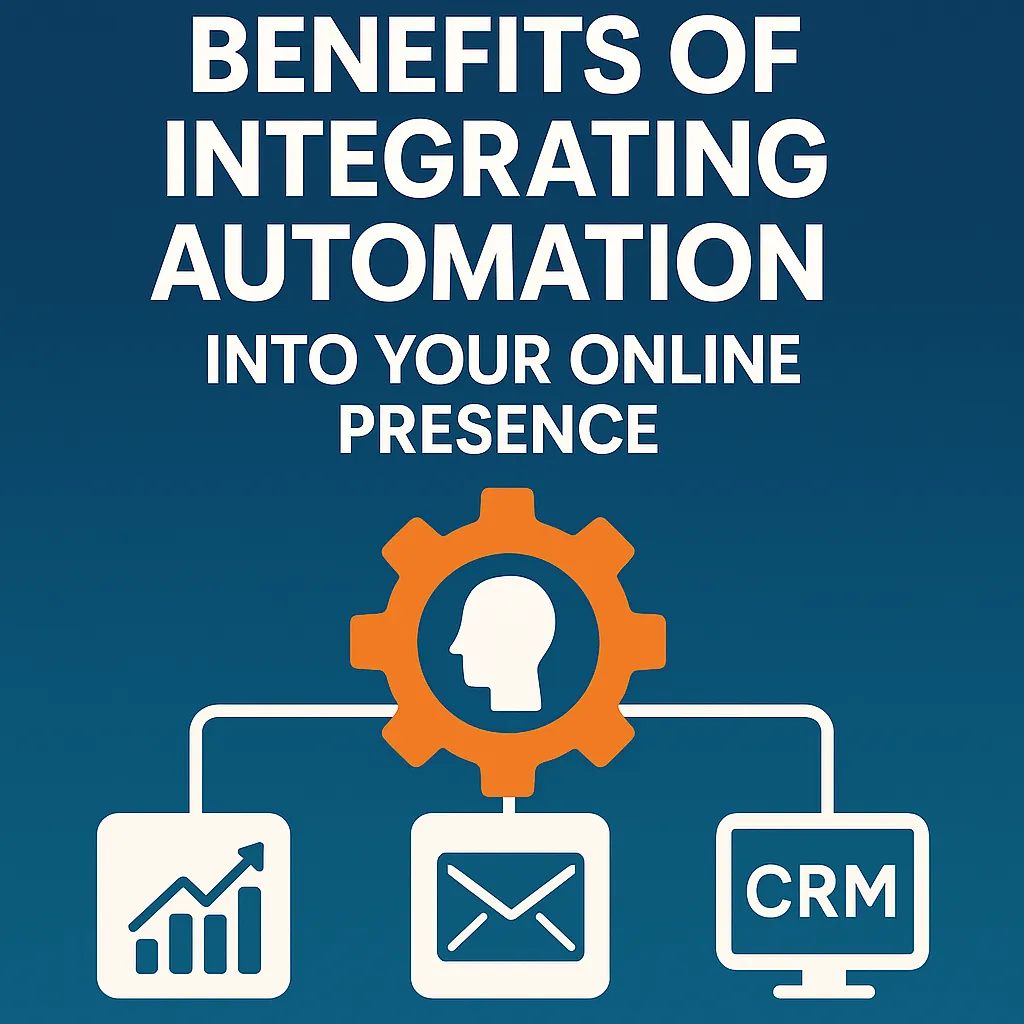
Digital Automation, Business Efficiency, Online Strategy, Marketing Automation 2025, CRM Tools.
SEO Blog Title:
Digital Automation, Business Efficiency, Online Strategy, Marketing Automation 2025, CRM Tools.
Meta Description:
Unlock higher efficiency and customer engagement in 2025. Discover the key benefits, tools, and strategies of integrating automation into your online presence.
H1: Benefits of Integrating Automation into Your Online Presence
In the hyper-connected, fast-paced digital world of 2025, standing out online is no longer just a matter of good design or a compelling message. It’s about speed, personalization, and operational intelligence—areas where automation plays a transformative role. Did you know that businesses using marketing automation see a 451% increase in qualified leads, according to VentureBeat? Whether you're a solo entrepreneur, a thriving e-commerce brand, or an enterprise-level organization, integrating automation into your online presence can be the key to unlocking higher efficiency, faster growth, and deeper customer engagement.
This comprehensive guide explores the essential benefits of automation in digital operations, tackles the best strategies to implement it, and provides actionable insights to help you harness its full potential starting today.
Let’s dive into how automation can become one of the smartest strategic decisions for your business’s online presence.
H2: Understanding the Concept: Definition and Key Concepts
Automation in the online space refers to using technology to perform repetitive or routine digital tasks with minimal human intervention. This includes activities such as:
Automating email responses and marketing campaigns
Managing customer interactions through AI-powered chatbots
Auto-posting content to social media platforms
Integrating sales funnels and managing leads through CRM tools
Historically, automation began in manufacturing and evolved into back-office operations. Today, it has transformed digital marketing, sales, and customer service. Modern tools like Go HighLevel (GHL) now combine Client Relationship Management (CRM) functionality with automation workflows, making it easier for businesses to manage leads, content, and client communications—all from a single platform.
Key advantages include:
Improved efficiency and productivity
Cost reductions through streamlined operations
Data accuracy and real-time insights
Enhanced customer experience with personalization
Real-world Example: A digital agency using Go HighLevel automates lead intake, nurturing sequences, appointment booking, and post-sale follow-ups—all without manual involvement. This reduces response time by 80%, resulting in significantly higher conversion rates.
H2: Why It Matters for Today’s Businesses
Modern consumers expect instant, personalized interactions. At the same time, competition is fiercer than ever online. To stay ahead, businesses must do more with less—and do it fast. That’s where automation becomes not just valuable, but essential.
According to McKinsey, 60% of all occupations have at least 30% of activities that could be automated using current technology. For businesses online, this directly translates to:
Automated lead generation and qualification
Streamlined content publishing
Real-time analytics and decision-making
Around-the-clock customer support without needing 24/7 staff
Tangible Benefits:
Operational Efficiency: Automating routine tasks frees up human capital to focus on strategic objectives.
Increased Profitability: Automation reduces reliance on manual labor and accelerates customer acquisition funnels.
Business Differentiation: Personalized, consistent engagement powered by automation builds stronger brand loyalty.
Example: A boutique e-commerce store using automation software for cart abandonment emails, restock alerts, and AI-powered upselling reports a 25% increase in average order value in six months.
H2: Effective Strategies to Master the Concept
Here’s a structured approach to successfully integrating automation into your online presence, using trusted tools and platforms.
Step 1 – Define Clear Objectives and KPIs
Before diving into tools, identify what you want to achieve:
Shorten response times?
Increase web traffic or leads?
Improve email campaign performance?
Use SMART goals (Specific, Measurable, Achievable, Relevant, Time-bound) and set benchmarks.
Step 2 – Build a Centralized CRM and Automation Hub Using Go HighLevel (GHL)
GHL offers built-in automations, sales pipelines, websites, and landing pages. You can visually map customer journeys, set up triggers for interactions, and integrate with email/text marketing—all in one dashboard.
Tip: Use GHL to automate:
Client onboarding
Drip campaigns
Appointment scheduling
Step 3 – Plan and Manage Projects Systematically with Notion or ClickUp
Use tools like Notion or ClickUp to manage project timelines, team collaboration, and editorial calendars. Structure your automation tasks, SOPs, and content pipelines to ensure everyone is aligned.
Step 4 – Optimize Domain and Site Performance with Namecheap and Cloudflare
Namecheap ensures seamless domain management, while Cloudflare boosts your site speed and shields against cyber threats.
Step 5 – Leverage Google Tools for Monitoring and Optimization
Google Analytics: Track performance, visitor behavior
Google Search Console: Monitor SEO health and visibility
Google Business Profile: Automate updates and local search engagement
H2: Common Mistakes Businesses Should Avoid
Even with the best tools, automation can backfire when poorly implemented. Avoid these common mistakes:
Mistake 1 – Automating Without Strategy
Not every task should be automated. Automating chaos amplifies inefficiencies.
Mistake 2 – Over-Automation Leading to Lack of Human Touch
Customers know when responses are robotic. Always pair automation with human oversight.
Mistake 3 – Ignoring Data Privacy and Compliance
Failure to align with GDPR, CCPA, or other data laws can lead to serious penalties.
H2: Getting Started: Practical Steps
Conduct an Audit of Your Business Processes
Select the Right Platform(s)
Map Customer Journeys
Set Up Your Workflows
Test and Optimize
H2: Frequently Asked Questions
Q: What tasks are best suited for automation in an online business?
A: Automated email marketing, lead scoring, chatbots, social media posting, appointment scheduling.
Q: How much does it cost to integrate automation?
A: Pricing varies from $97/month to $5,000+/month depending on tools and scale.
Q: Will automation replace my team?
A: No, automation empowers your team by handling repetitive tasks.
Q: Is automation hard to implement?
A: Tools like GHL and ClickUp offer intuitive interfaces and ready-to-use templates.
Q: How do I measure the success of automation?
A: Common metrics include time saved, conversion rates, response times, and ROI.
